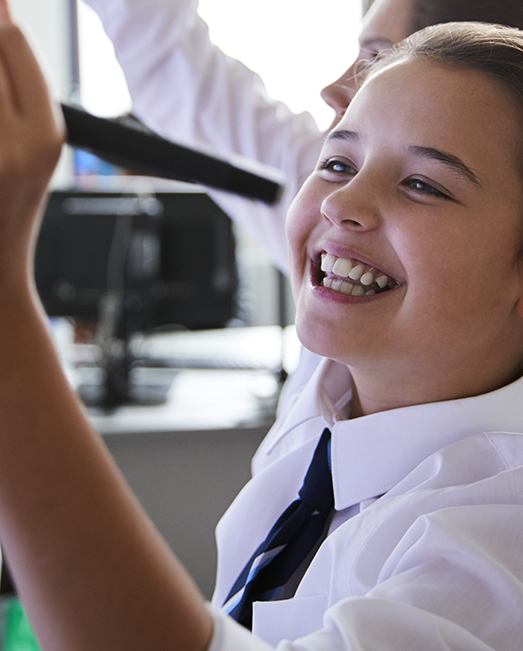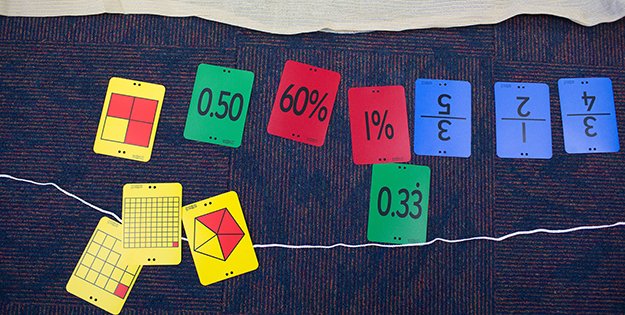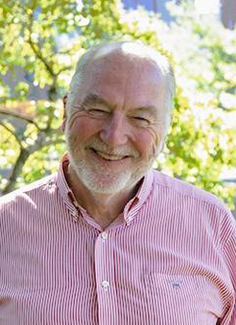Community
Copyright@ Australian Catholic University 1998-2026 | ABN 15 050 192 660 CRICOS registered provider: 00004G | PRV12008
Copyright@ Australian Catholic University 1998-2026 | ABN 15 050 192 660 CRICOS registered provider: 00004G | PRV12008

John Munro was teaching a class of year eight science students about the human digestive system, the way it breaks down food into nutrients that are then absorbed into the bloodstream. At different stages of the lesson, he paused to pose a question that he likes to ask of young learners.
“When I’m teaching a group of kids,” he says, “I always say to them, ‘Has anyone thought of anything I haven’t mentioned?’”
It’s a simple teaching technique that leaves an opening for those students prepared to share their intuitive theories.
Some days, the question yields no response. On this day, it did.
“One of the girls asked, ‘So, how do the glands in the wall of the stomach know how much acid to squirt out, to break down the proteins in the food?’ And I thought, well, that’s something that has never entered my mind. And I’ve only been teaching for 50 years.”
Professor Munro had already explained how the food moves from the mouth into the stomach, where the proteins are further broken down by acid secreted from the glands. If there was too much acid in the stomach, he told the students, it could do damage and cause ulcers.
“I left it at that, not giving any further explanation, and that’s when the girl asked, ‘How do the glands know?’. And then I responded, ‘Why do you ask that?’”
The girl, named Gina, went on to explain: “Well, you said that if you have too much acid, you’re going to get ulcers, and if you don’t have enough acid, you won’t break down food. Yesterday, I could have had a big burger; today, I could have had a salad. My stomach would need different amounts of acid. So, there must be something in the stomach that works out just how much acid to squirt. When you look at the food, do your eyes somehow assess it? Or are there indicators in the stomach that tell your glands how much acid to squirt out?”
With the minimal information presented to her, Gina had formed an intuitive theory about how digestion happens in the stomach, bringing in the complex processes of the automatic nervous system and the way it regulates bodily functions.
Professor Munro quickly recognised the possibility that her theorising was the behaviour of a gifted learner: a student with the capacity for creative and innovative thinking.
In many classrooms, her question might have been dismissed or deflected—or even worse, it might never have been asked.
“I think it’s really important that teachers give students the opportunity to present their intuitive theories, and you might do that very simply by saying, ‘Has anyone thought of anything else?’ Or, as I’m teaching, I might say, ‘What do you think might happen here? Where might that go?’” he says.
“The more I do that, the more I allow the students to bring their intuitive theories out, and then to evaluate, infer, synthesise and unpack their theory. And that’s better for all students, not just the gifted kids.”
John Munro knows how to spot a gifted child.
Over a career spanning five decades as a schoolteacher, registered psychologist, tertiary educator and prolific researcher, he has come to know the signs of a so-called ‘child genius’, the different ways they respond to new information.
In classrooms all over the world, schoolteachers provide information to students to help them transform it into knowledge.
Some students do that better than others, at different speeds and in different ways.
“Most students are one or two steps behind the teacher, and as the teacher provides the information bit by bit, they will follow along and are successfully programmed to form an essentially literal understanding,” says Munro, Professor of Educational Psychology and Exceptional Learning at Australian Catholic University’s (ACU) National School of Education.
“There are sometimes one or two students who do more than this. They take the information, and rather than being programmed, they make links with other ideas you haven’t mentioned, generating a much richer interpretation than their peers.”
Some students infer the direction of the teaching and extend their interpretation by adding to it. They often seem to be just ahead of where the teacher is.
Other students make links with ideas that often seem unrelated to the topic. They come up with lateral, unexpected and creative interpretations. They might see actions or moves that respond to challenges and solve problems in innovative or unusual ways.

The intuitive theories of these gifted children are not always right. They’re often speculative, and parts of their theories are untested.
Given the chance, however, they might just produce a spark of brilliance that enlightens their peers (and, in many cases, their teachers).
“Some of these kids, the way they can see things and see possibilities, it’s just amazing,” says Professor Munro, who labels gifted learners as “potentially our future Einsteins”.
“Their thinking can really enlighten everyone, but they will do this only if we support them to learn in an appropriate way – and often they don’t get that opportunity.”
At the heart of giftedness education in Australia is a theory developed by the French-Canadian educational psychologist, Francoys Gagne.
Gagne’s model posits that students with gifted natural ability can form talented outcomes only under particular conditions.
These include the ‘intrapersonal’ (including intrinsic motivation and volition), the ‘environmental’ (including parental support, socioeconomic status and access to knowledgeable teachers and stimulating resources), and ‘chance’.
John Munro believes Gagne’s model is a useful tool for differentiating between giftedness and talent, and for identifying some crucial factors in the conversion of giftedness to talent. But he also believes it’s missing a clear, explicit description of how a gifted student’s knowledge changes as they move towards talent development in the classroom.
“The model appears to assume that it often comes down to ‘chance’—that given the right circumstances, the talented outcome can happen, but sometimes it doesn’t,” Professor Munro says. “I don’t think that’s adequate.”
Teachers who come into contact with gifted learners know that talented outcomes are not random, lucky or accidental.
“As teachers, we can deal with the notion of chance by modifying our practice to encourage the student’s intuitive interpretations of the teaching,” he adds.
“If I, as a teacher, look for these intuitive theories and high-level interpretations, if I foster them and scaffold the student to analyse them and unpack them, they are more likely to lead to the talented outcome.”
Through their teaching, the teachers are managing the impact of chance.
“At the moment, we often don’t do that, and that means we don’t cater to the brighter students, and this is because the model we’re using is incomplete. It’s missing a crucial step.”
Professor Munro is proposing a modification to the model. He recommends that it include an explicit focus on the intuitive theories or interpretations that gifted students form.
“It needs to make direct reference to these interpretations that occur between the natural ability, and the talented outcome. Then teachers will know to look for them and guide them to advanced products.”
This, he believes, is the missing piece of the puzzle in giftedness education.
It will aid teachers in identifying, understanding and nurturing gifted children—especially those with learning difficulties and disorders.
Many gifted learners also have learning deficits in certain areas.
These students are known as “twice exceptional”, and their giftedness in one area is often overshadowed by their disability in another.
“Many of the most creative people this world has known are twice-exceptional,” Professor Munro writes in The Conversation. “This includes scientists such as Einstein, artists such as Van Gogh, authors such as Agatha Christie and politicians such as Winston Churchill.”
Teachers tend to have limited procedures for identifying the different types of gifted learners, and often mistake their unique interpretations for other things.
That means that twice-exceptional students – those whose way of seeing the world often doesn’t suit the programmed nature of the modern classroom – are often the most likely to be neglected, ignored and misunderstood.
“These students can only thrive and excel when they have the opportunity to show their advanced interpretations in formats that they can manage … for example, in visual or physical ways,” Professor Munro says. “They can then learn to use more conventional ways, such as writing, to share their interpretations.”
Nurturing and encouraging all types of gifted students gives them a better chance of realising their potential, which may just be of benefit to us all.
When given the opportunity, they can help us to think outside the box, to develop a deeper understanding of complex processes.
Take Gina, who was intrinsically motivated to know more about digestion in the stomach, and allowed her classmates to discover that chemical reactions not only help to digest food, but also control when and where it occurs.
“Gifted learners are innovators,” Professor Munro says. “They give us the big ideas, possibilities and options … They have the potential to contribute significantly to our world, and to change how we live.”
John Munro is Professor of Educational Psychology and Exceptional Learning at ACU’s Melbourne Campus. He is also a primary and secondary schoolteacher and a registered psychologist. His research interests include gifted learning, learning difficulties and school improvement.

Passionate about learning? Explore the courses available at ACU.
Copyright@ Australian Catholic University 1998-2026 | ABN 15 050 192 660 CRICOS registered provider: 00004G | PRV12008